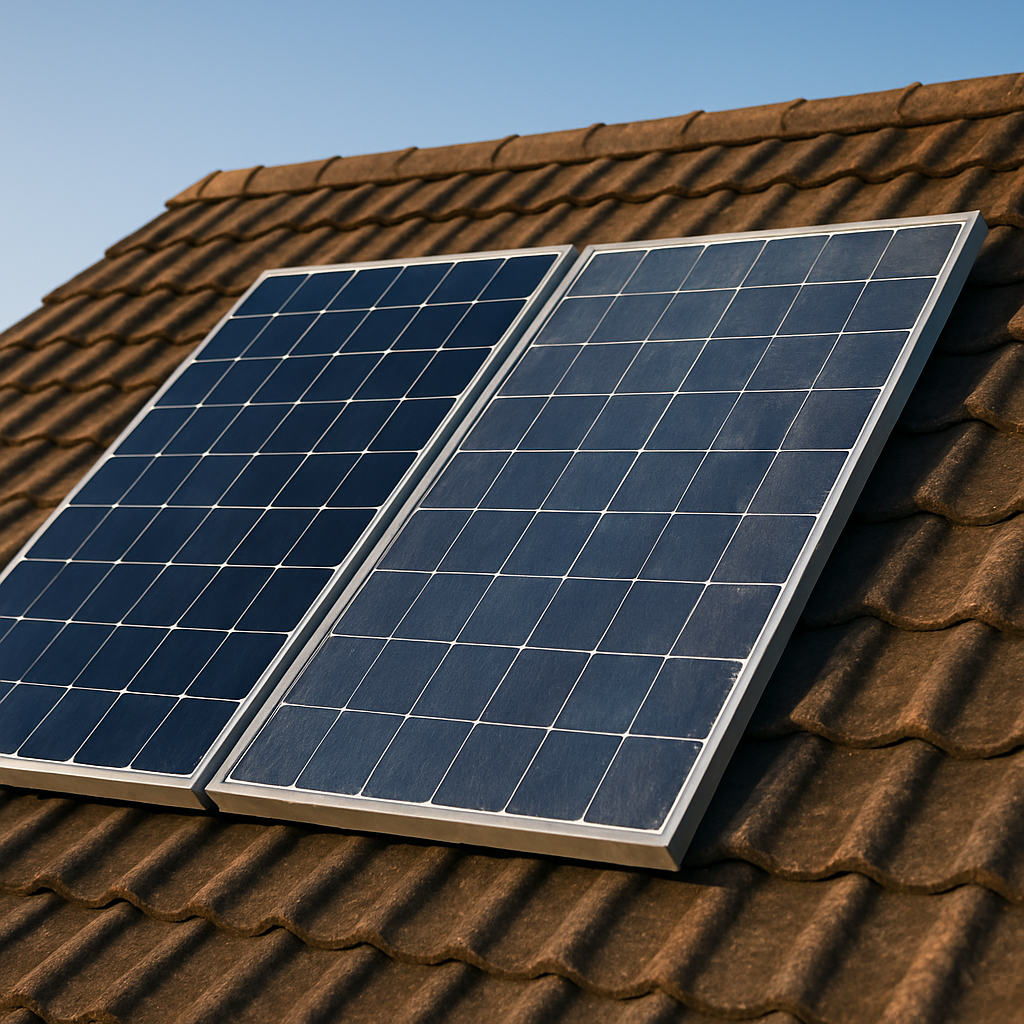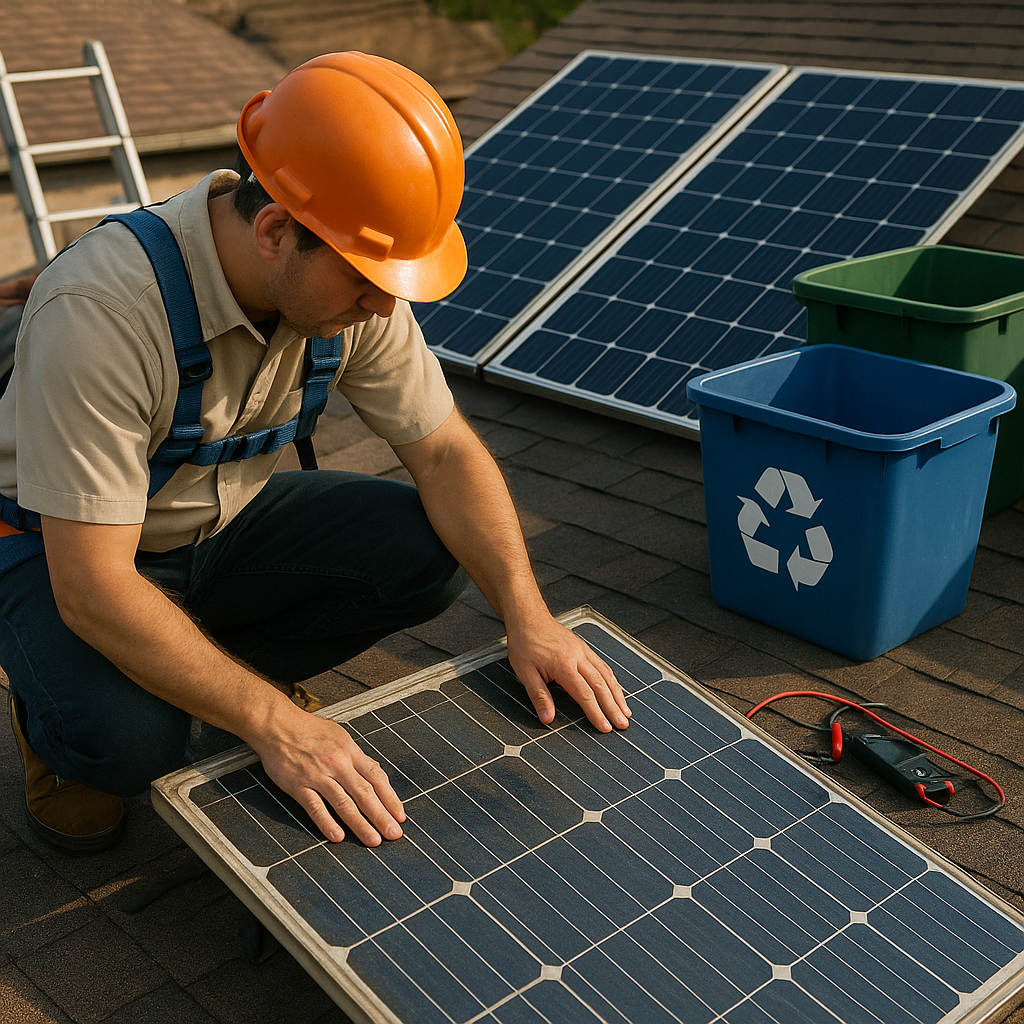5901 Botham Jean Blvd, Dallas, TX 75215
What Happens to Solar Panels After 25 Years?
July 18, 2025Solar panels don’t simply stop working at the 25-year mark. In fact, most continue generating electricity for many years beyond their warranty period. After a quarter-century of service, typical photovoltaic cells still operate at 80-90% of their original capacity, maintaining impressive efficiency despite their age.
The degradation process is gradual, with solar panels losing approximately 0.5% to 0.8% of their productivity annually. This means that after 25 years, a high-quality solar panel system will still capture and convert most sunlight it receives into usable electricity. The panels don’t suddenly fail—they become slightly less efficient over time.
Many homeowners and businesses face a decision point when their solar power systems reach this milestone. While the panels remain functional, their reduced output might prompt consideration of replacement to maximize energy production. However, as most systems maintain over 80% efficiency after 25 years, many owners continue using their original installations for additional years of renewable energy generation.
How Much Do Solar Panels Degrade Over 25 years?

Solar panel degradation is an inevitable process as these systems age. Manufacturers generally design performance warranties based on an expected efficiency loss, typically guaranteeing 90% of original production capacity for the first 10 years and 80% for the remaining 15 to 20 years. This standard warranty structure reflects the gradual degradation occurring over a panel’s lifetime.
However, real-world data is often more optimistic than these warranty benchmarks. A comprehensive study by the National Renewable Energy Laboratory (NREL) analyzed nearly 2,000 solar systems worldwide, finding that modern monocrystalline panels manufactured after 2000 degrade at just 0.4% annually—a significant improvement over the 0.5% to 0.8% rate many warranties anticipate. This means a typical high-quality solar panel might lose only 6% to 8% of its efficiency after 25 years, compared to the 20% loss manufacturers prepare for in their warranties.
Panel quality greatly affects degradation rates. Premium manufacturers, like Panasonic and SunPower, offer panels with degradation rates as low as 0.25% to 0.3% per year, meaning their panels could still operate at 93% of their original capacity after 25 years. Standard tier-two panels with 0.5% annual degradation would operate at around 88.7% efficiency, while budget options with 0.8% degradation might drop to 82.5% capacity over the same period.
Several environmental factors influence degradation rates. Thermal cycling—repeated temperature changes—creates microcracks in silicon cells over time. UV light exposure gradually damages the materials in solar cells and their coatings. High humidity can alter conductivity if moisture penetrates the panel, while potential-induced degradation (PID) occurs when voltage differences between solar cells and other components cause leakage currents.
Geographic location significantly impacts degradation rates. Systems in regions with extreme temperature swings or high humidity degrade faster than those in moderate climates. PVEL (PV Evolution Labs) analysis of 36 solar projects in India found systems in colder, mountainous regions degraded at nearly half the rate (0.7%) compared to the average (1.47%) across all sites.
For waste management professionals, understanding these degradation patterns is essential for planning end-of-life processing. Most solar panels continue producing useful electricity well beyond their warranty period, albeit at reduced capacity. This extended functional lifespan must be considered when developing recycling programs and infrastructure to efficiently handle these materials when they reach the end-of-life stage.
What Factors Affect Solar Panel Performance After 25 years?
Solar panels are designed to provide clean energy for many years, but several factors influence their performance beyond the 25-year mark. Understanding these elements helps owners maximize their investment and plan for the future of their renewable energy systems.
Panel quality and manufacturing technology are key determinants of long-term performance. Premium monocrystalline panels from top manufacturers like Maxeon and LG typically maintain higher efficiency with degradation rates as low as 0.3% annually. This means they could still operate at 92% of their original capacity after 25 years, while standard panels with a 0.8% degradation rate might drop to around 82.5% efficiency.
Environmental conditions significantly impact panel longevity. Heat is particularly challenging, as high temperatures reduce real-time efficiency and accelerate degradation through thermal cycling. This continuous expansion and contraction during temperature changes creates microcracks in the silicon cells. Studies by PVEL found panels in cooler, mountainous regions degraded nearly half as fast (0.7%) as those in hotter areas (1.47%).
Weather exposure contributes to several degradation mechanisms. Strong winds cause panel flexing and microcracking through dynamic mechanical load. UV radiation triggers light-induced degradation (LID), which can lead to a 1-3% efficiency drop in the initial hours of sun exposure. Heavy snow loads and hail impacts can physically damage panels, though most designs are built to withstand these conditions.
Installation quality plays a crucial role in system longevity. Proper mounting techniques that allow air circulation beneath panels help mitigate heat-related issues. Ensuring adequate spacing between panels, correct tilt angles, and secure attachment methods all contribute to extending panel life.
Voltage management affects panel health through potential-induced degradation (PID). This occurs when voltage differences between solar cells and other components trigger ion migration, reducing power output. Manufacturers address this with PID-resistant materials in glass, encapsulation, and diffusion barriers.
Maintenance practices significantly impact long-term performance. Regular cleaning removes efficiency-reducing debris, while periodic professional inspections can identify issues before they cause major problems. Prompt replacement of supporting components like inverters (which typically last 10-15 years compared to panels’ 25-30 years) ensures the system continues to operate efficiently.
Manufacturer quality control greatly influences panel durability. Panels certified to IEC 61215 standards undergo rigorous testing for electrical safety, mechanical load tolerance, and climate resistance. These certifications help ensure panels will withstand real-world conditions over decades of use.
What Are the Options For Solar Panels After 25 years?

When solar panels reach the 25-year mark, they don’t simply stop working. Instead, they continue to generate electricity, albeit at reduced efficiency. Most panels operate at about 80-85% of their original capacity after 25 years, gradually degrading at a rate of 0.5-0.8% annually. This leaves solar panel owners with several practical options to consider.
Continue Using Existing Panels
Many homeowners choose to keep their original solar panels even after the 25-year warranty expires. These panels remain functional and continue producing electricity at no additional cost. Although the output is lower than when first installed, the panels still generate free power that offsets utility bills.
This option makes financial sense for many households, especially if the system was paid off years earlier. The electricity generated, even at reduced efficiency, comes at zero additional cost. Some high-quality panels may even maintain up to 90% of their original output after 25 years with proper maintenance.
Upgrade to Newer, More Efficient Technology
Technology advances rapidly, and solar panels are no exception. Systems installed today produce significantly more power than those from two decades ago. Upgrading to newer models offers substantial benefits in energy production and space efficiency.
Repowering your system by replacing older panels with newer, high-efficiency models allows you to generate more electricity from the same roof space. Many homeowners take this opportunity to also upgrade inverters or add battery storage systems. The mounting hardware and electrical infrastructure from the original installation can often be reused, reducing the overall cost of upgrading.
Recycle End-of-Life Solar Panels
When panels are too degraded to be useful or when upgrading makes more sense, recycling provides an environmentally responsible disposal option. Solar panel recycling is becoming increasingly sophisticated, with specialized facilities able to recover up to 95% of materials from old panels.
The recycling process typically begins with removing the aluminum frame and junction box. The panels then undergo either mechanical shredding or thermal processing to separate the various components. Glass, which constitutes about 75% of a panel’s weight, is easily recovered and repurposed. Valuable metals like silver and copper are extracted from the cells and wiring through chemical processes.
As the solar industry matures, recycling infrastructure continues to expand. Several manufacturers now offer take-back programs, and specialized recycling companies are emerging to handle the growing volume of decommissioned panels.
Second-Life Applications
Another option gaining popularity is repurposing older solar panels for secondary applications. Panels that no longer meet the efficiency needs of a primary residence might be perfectly suitable for less demanding uses.
These second-life applications include powering outbuildings, garden features, or off-grid structures like cabins or RVs. Some homeowners donate their used panels to community projects or sell them on the secondary market, extending their useful life while helping others access solar energy at a reduced cost.
Each of these options offers different benefits depending on your specific situation, energy needs, and budget. By planning ahead, solar panel owners can maximize their investment while minimizing environmental impact when their systems reach the 25-year milestone.
Conclusion: Planning for the future of your solar investment
Investing in solar energy systems is a long-term commitment that continues to deliver benefits long after installation. Although solar panels typically show signs of aging after 25 years, they often continue generating clean energy for decades beyond their warranty period. The standard performance life of 25-30 years is just the beginning of a potentially much longer energy production timeline.
Understanding degradation rates, monitoring performance factors, and planning for end-of-life management are key components in maximizing your solar investment returns. With proper maintenance and realistic expectations, solar installations can provide significant financial and environmental benefits well into the future. For professional recycling services when your solar panels eventually reach the end of their useful life, contact Okon Recycling at 214-717-4083.
